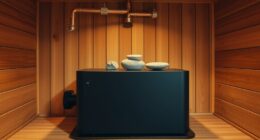Many believe ventilation isn’t needed in small saunas or that sealing vents keeps the heat in better. Some think installing vents will cool your sauna too much, or that bigger openings always improve airflow. Others assume ventilation only matters during heating or that opening windows during a session cools it excessively. However, proper ventilation balances humidity and air quality without overcooling. Understanding these myths helps you optimize comfort and safety—keep going to uncover the full picture.
Key Takeaways
- Airtight sealing traps moisture and promotes mold, rather than improving heat retention, if vents are not properly designed.
- Small vents are often underestimated; their placement and system design matter more than size for effective airflow.
- Excessive ventilation can cool the sauna too much and reduce humidity control, negatively affecting comfort and safety.
- Continuous ventilation with fans is essential for moisture removal and air quality, not just initial heat-up.
- Proper ventilation focuses on odor and moisture management, safety relies on fire and electrical precautions, not vent size alone.
Proper Ventilation Isn’t Necessary in Small Saunas
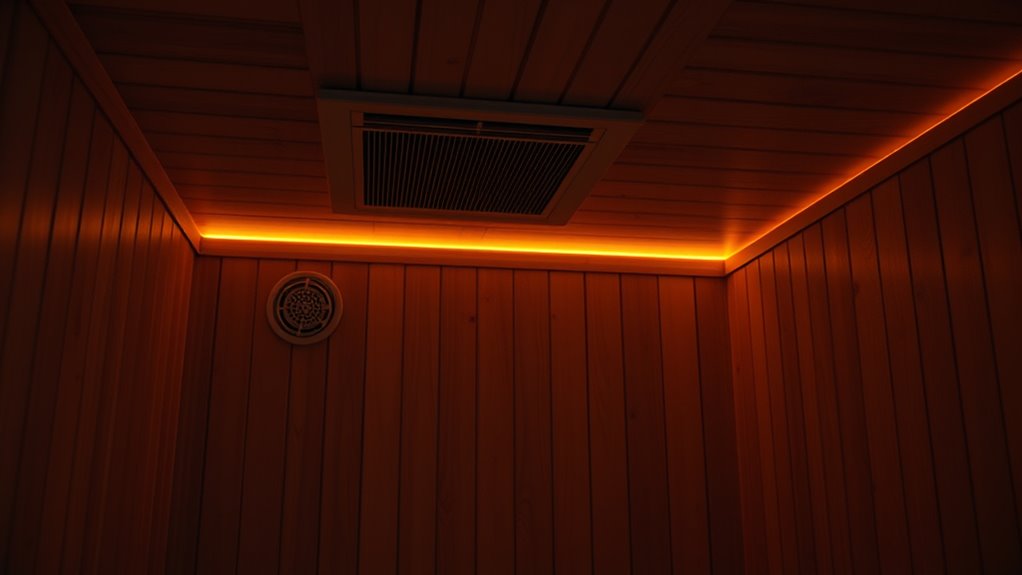
Many people assume that small saunas don’t need proper ventilation, but this isn’t entirely true. Ventilation myths often suggest that sealing a small sauna completely will trap heat and humidity perfectly, making ventilation unnecessary. This misconception can lead to problems like excess moisture buildup and poor air quality. Proper airflow helps remove sweat, odors, and excess humidity, keeping the environment comfortable and safe. Sauna misconceptions wrongly imply that sealing a small space tightly will improve efficiency, but without adequate ventilation, you risk mold growth and stuffiness. Ventilation isn’t about cooling down the space but maintaining healthy air circulation. Even in small saunas, ensuring some airflow is essential for comfort, safety, and longevity of the sauna materials. Incorporating proper ventilation systems can significantly improve indoor air quality and prevent long-term damage. Don’t fall for these common sauna myths.
Ventilation Should Be Completely Sealed to Keep Heat in

Sealing a small sauna completely to retain heat might seem like an effective strategy, but in reality, it can cause more harm than good. An airtight design traps moisture and carbon dioxide, leading to poor air quality and increased humidity. This can create discomfort and even health risks. Proper ventilation is essential for maintaining safe airflow and heat retention. Consider these points:
Sealing a sauna completely can trap moisture, harm air quality, and increase health risks without proper ventilation.
- Over-sealing can cause mold growth due to excess moisture buildup.
- Without fresh air exchange, the sauna’s environment becomes unhealthy and stuffy.
- Adequate ventilation helps regulate temperature, ensuring consistent heat retention without sacrificing air quality.
- Utilizing proper ventilation techniques can optimize heat retention while maintaining a safe and comfortable environment.
Installing Vents Will Cool Down the Sauna Excessively
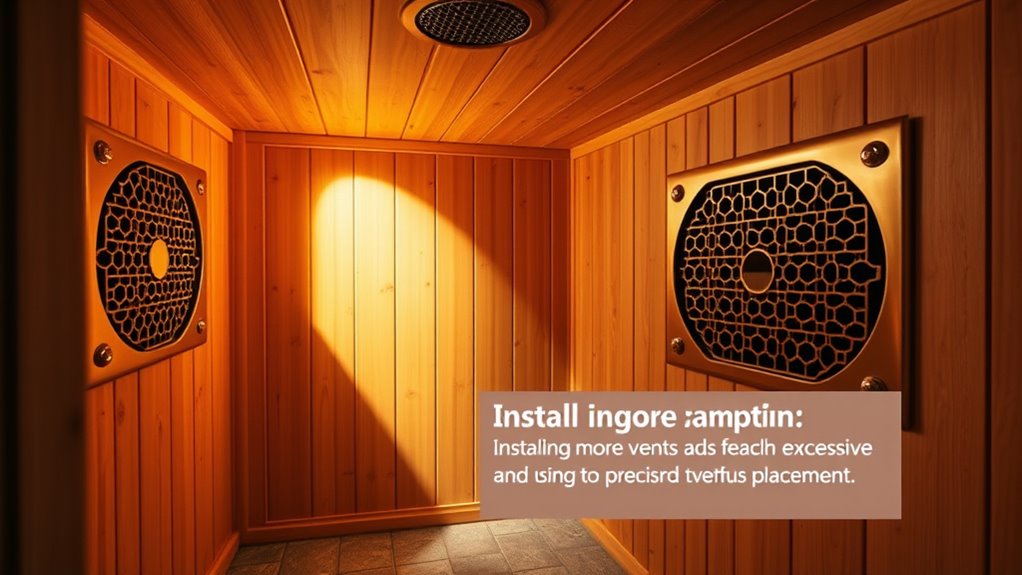
Installing vents might seem like a simple way to cool your sauna, but don’t overestimate their impact. Even small openings can let in more air than you expect, reducing heat too much. Plus, ignoring humidity control can make the temperature feel inconsistent and uncomfortable. Additionally, proper ventilation can help manage air quality, which is essential for a safe and enjoyable sauna experience.
Overestimating Vent Effectiveness
While adding vents might seem like an easy way to cool down a small sauna, overestimating their impact can lead to disappointment. Many fall for ventilation myths, believing vents alone will substantially lower temperatures. This is a common vent misconception. In reality, small vents can help with air circulation but won’t drastically reduce heat. Additionally, understanding the scope of ventilation and its actual effect is crucial to setting realistic expectations. Consider these points: 1. Ventilation increases airflow but doesn’t remove enough heat to cool the entire space effectively. 2. Proper insulation and heating control are more essential for temperature regulation. 3. Relying solely on vents can lead to false expectations about cooling efficiency, fueling vent misconceptions. Understanding these limits prevents you from overestimating vent effectiveness and ensures you focus on more reliable cooling methods.
Ignoring Humidity Control
Many sauna owners believe that adding vents will considerably cool down the space, but they often overlook the role of humidity in temperature perception. Humidity regulation is essential because moisture levels influence how hot a sauna feels, not just the actual temperature. Without proper moisture management, vents can cause unnecessary cooling, making the sauna less effective and more uncomfortable. Instead of focusing solely on ventilation for cooling, prioritize controlling humidity to maintain consistent heat and comfort. Proper moisture management helps prevent excess dryness or dampness, ensuring the sauna remains warm without overcooling. Additionally, understanding how humidity affects heat perception can help you better manage your sauna environment. By understanding the importance of humidity regulation, you can optimize ventilation to improve comfort without risking excessive cooling or losing heat.
More Ventilation Always Means Better Airflow and Comfort
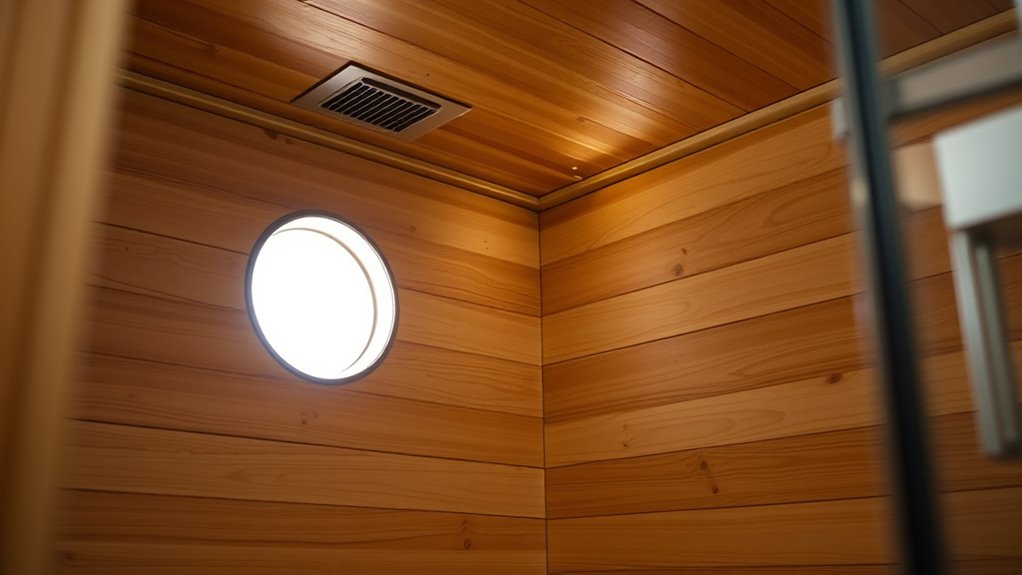
Adding more ventilation can improve the air quality in your sauna, making it more comfortable and healthier to use. However, overventilating can lead to unnecessary heat loss and energy waste. Finding the right balance guarantees you get fresh air without sacrificing warmth or efficiency. Proper ventilation also plays a role in maintaining optimal airflow in small sauna rooms, ensuring a pleasant experience.
Improved Air Quality
Improved air quality in small sauna rooms hinges on increasing ventilation, which helps to circulate fresh air and remove excess humidity and odors. Proper airflow reduces indoor pollution, making your sauna healthier and more comfortable. When ventilation is optimized, you prevent stale air from lingering, decreasing the risk of mold and bacteria buildup. To enhance air quality effectively, consider these key points: 1. Balance airflow to avoid over-ventilating, which can cause discomfort. 2. Use high-quality vents or exhaust fans to actively remove indoor pollution. 3. Regularly maintain ventilation systems to ensure consistent fresh air supply. Proper ventilation system maintenance is essential to keep airflow functioning optimally and prevent build-up of unwanted airborne contaminants.
Avoid Overventilating
While increasing ventilation in your small sauna can improve air quality, overventilating can lead to discomfort and energy waste. Too much airflow disrupts the humidity balance, making it harder to maintain a comfortable environment. Excessive air circulation can cool the room too quickly, preventing you from reaching the desired temperature and causing unnecessary energy use. It may also cause drafts that make the experience less relaxing. To avoid this, find a balance by ventilating enough to refresh the air without overwhelming the space. Use controlled airflow, and monitor humidity levels regularly. Proper ventilation promotes good air quality while preserving the cozy, warm atmosphere essential for a satisfying sauna session. Remember, more isn’t always better when it comes to ventilation. Understanding ventilation systems can help you optimize airflow and maintain comfort efficiently.
Ventilation Is Only Needed During the Sauna’s Heating Phase
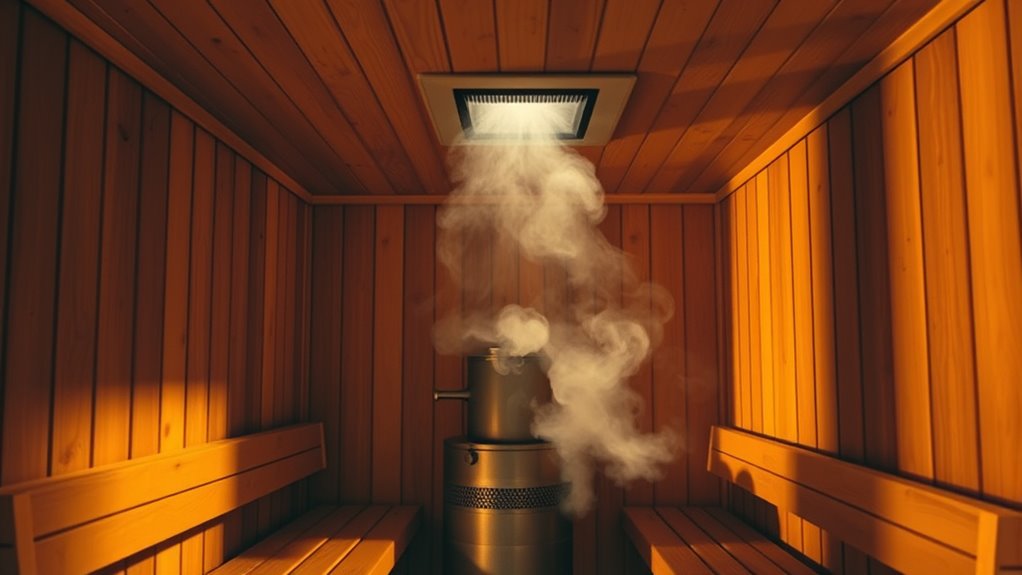
Is ventilation only necessary when heating your small sauna room? Not at all. Proper ventilation ensures good air quality and moisture control throughout your sauna experience. Relying solely on ventilation during the heating phase overlooks the importance of continuous air exchange.
A Bluetooth connection can help monitor and automate ventilation settings for optimal air quality.
Consider these points:
- Moisture builds up even after heating stops, risking mold and damage.
- Air quality can decline as sweat and humidity linger inside.
- Ongoing ventilation helps maintain a comfortable environment, preventing stuffiness.
You need consistent airflow to manage moisture and freshen the air, not just during the heat-up. Proper ventilation safeguards your sauna’s longevity and makes your sessions more enjoyable and healthier.
Fans Are the Best Solution for All Sauna Ventilation Issues
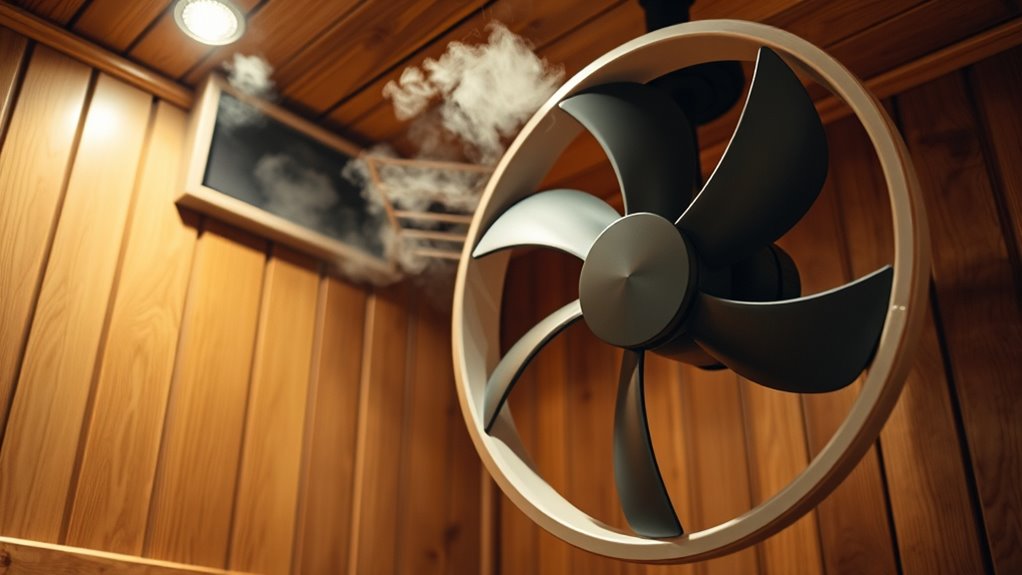
When it comes to solving ventilation issues in your small sauna, fans stand out as the most effective solution. They improve air quality by circulating fresh air and removing stale, humid air that can build up during sessions. Proper airflow helps regulate moisture levels, preventing mold and wood damage. Fans can be strategically placed to ensure consistent ventilation throughout the sauna, regardless of occupancy or heat levels. Unlike passive methods, they provide immediate and adjustable airflow, giving you control over the environment. This keeps the air clean, reduces excess moisture, and maintains a comfortable, healthy space. Overall, fans are reliable, easy to install, and essential for managing ventilation challenges in small sauna rooms. Effective ventilation strategies are crucial for maintaining the longevity and safety of your sauna.
Opening Windows or Vents During a Session Cools the Sauna Too Much
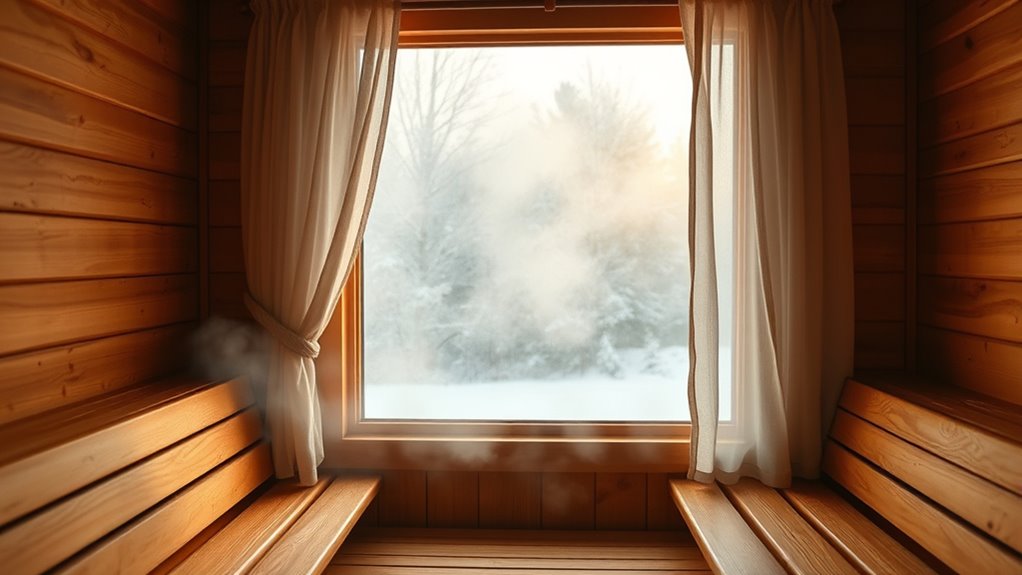
Opening windows or vents during a sauna session might seem like a quick way to cool down, but it often causes more harm than good. You risk disrupting proper temperature regulation and air exchange, which are vital for an effective sauna experience. When you open vents prematurely, you let in cooler air and exhaust warm, humid air, causing a sudden drop in temperature. This can lead to a less consistent heat and prevent you from reaching the desired sweat-inducing conditions.
Consider these points:
- Excessive air exchange cools the sauna too quickly, undermining the session’s benefits.
- Maintaining a stable environment helps sustain ideal temperature regulation.
- Interrupting the heat flow hampers the sauna’s ability to circulate air efficiently, reducing its effectiveness.
The Size of the Ventilation Openings Doesn’t Matter as Long as They Exist
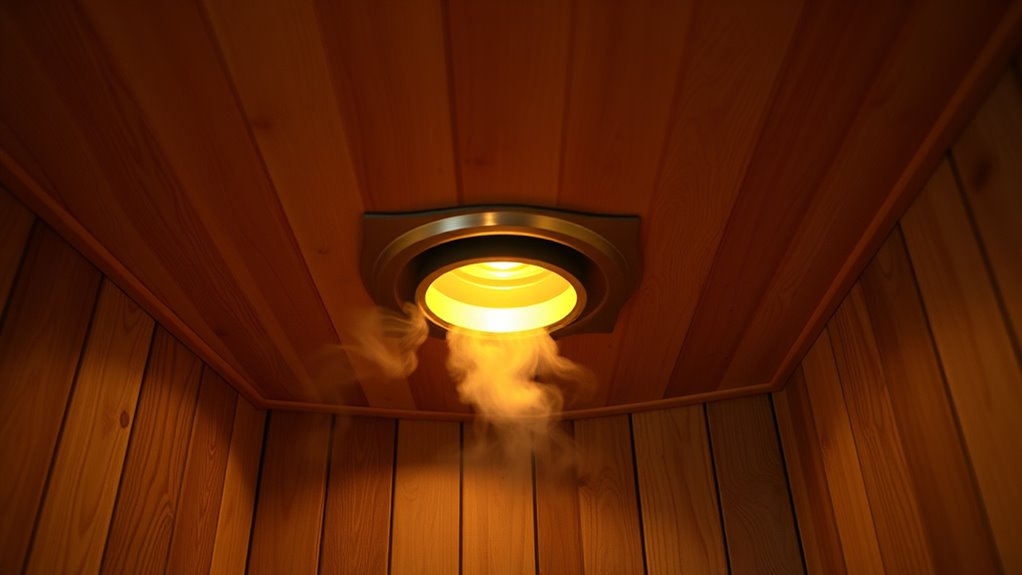
The size of your ventilation openings doesn’t matter as long as they’re present and functional. What truly matters is ventilation size that allows adequate airflow efficiency. Small openings can be just as effective as larger ones if they’re properly designed and positioned, ensuring fresh air enters and stale air exits efficiently. It’s a common misconception that bigger vents automatically improve ventilation, but size alone won’t guarantee good airflow. Instead, focus on proper placement and the overall balance of your ventilation system. Proper airflow efficiency depends on how well the openings work together with the sauna’s internal environment. As long as your vents are capable of maintaining steady airflow, their size is secondary. Effective ventilation is about function, not just the physical dimensions.
Small Saunas Don’t Need Special Ventilation Considerations
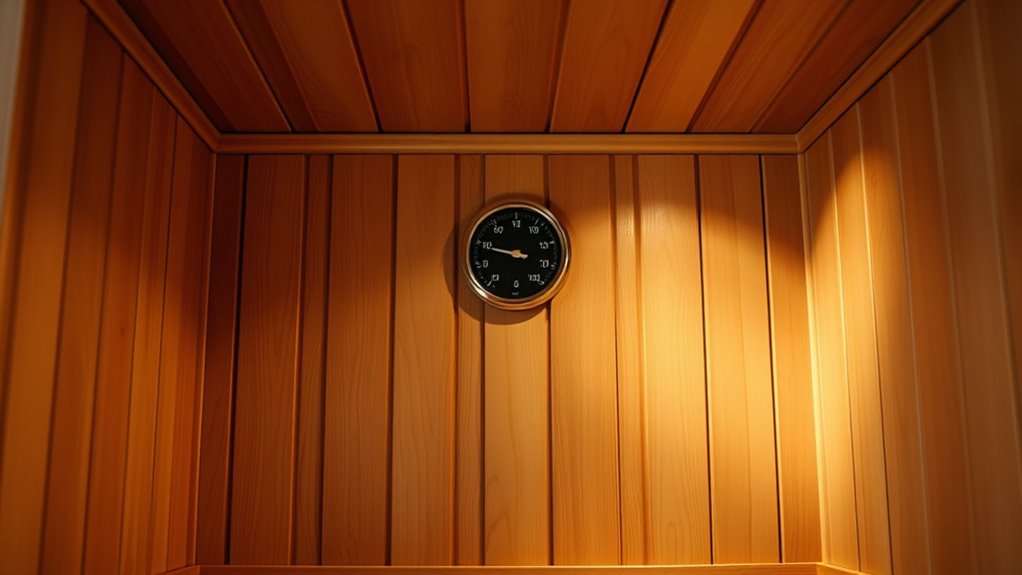
Small saunas typically have less complex ventilation needs because their compact size allows for easier airflow management. You might think they don’t require special considerations, but proper ventilation still impacts air exchange and moisture control. Without adequate airflow, humidity can build up, causing discomfort and potential damage. To ensure ideal conditions, consider these points:
- Maintain sufficient air exchange to prevent stale air and ensure fresh oxygen.
- Use targeted vents or openings for humidity management, avoiding excess moisture buildup.
- Regularly check ventilation paths to keep airflow unobstructed and moisture levels balanced.
Even in small spaces, paying attention to ventilation helps maintain a comfortable, safe environment while protecting the sauna’s structure. Good airflow isn’t just for larger rooms; it’s essential everywhere.
Ventilation Is Primarily for Controlling Odors and Not Safety
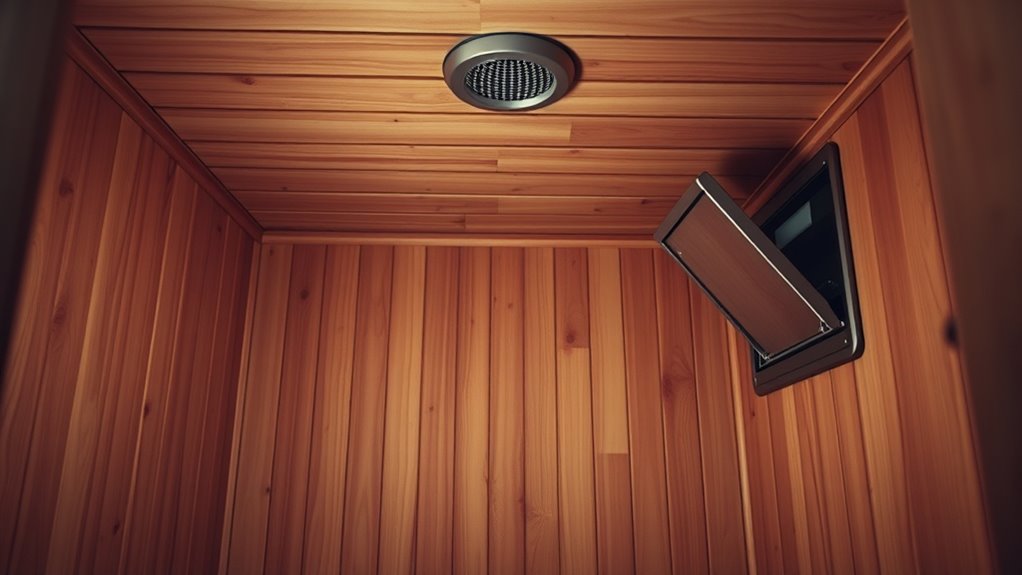
Most small sauna ventilation systems are designed to keep odors in check rather than guarantee safety. While proper airflow helps prevent unpleasant smells, it isn’t primarily about protecting you from danger. Focus on odor control, and safety concerns can be addressed separately if needed.
Odor Management Focus
Although ventilation plays a role in safety, its primary purpose in small sauna rooms is to control odors. Proper air circulation helps eliminate lingering smells from sweat, oils, and cleaning products. When you focus on odor management, you create a more pleasant environment, encouraging relaxation. To achieve effective odor elimination, consider these key points:
- Ensure continuous airflow to prevent stagnant air buildup.
- Use vents strategically to promote even air exchange.
- Regularly maintain and clean ventilation components to sustain odor control.
Safety Not Primary
Did you know that ventilation in small sauna rooms is mainly aimed at controlling odors rather than guaranteeing safety? While good air circulation helps keep the space fresh, it’s a misconception that ventilation alone guarantees fire safety. Proper ventilation reduces humidity and prevents mold, but it doesn’t eliminate fire hazards. In fact, many overlook that ventilation systems are not designed to prevent fires or signal dangerous conditions. Instead, fire safety relies on proper electrical wiring, heating equipment, and safe use practices. Relying solely on ventilation to address safety concerns can be risky. Always ensure your sauna has appropriate fire safety measures, like smoke detectors and accessible exits, alongside effective air circulation to maintain a safe environment.
Frequently Asked Questions
Can Improper Ventilation Cause Health Issues in Small Saunas?
Yes, improper ventilation can cause health issues in small saunas. Poor ventilation reduces air quality, making it hard to breathe comfortably, and leads to moisture buildup. Excess moisture promotes mold growth, which can trigger allergies or respiratory problems. Without proper airflow, you risk inhaling stale, damp air, increasing the chances of illness. Ensuring good ventilation keeps the air fresh, moisture levels controlled, and your sauna experience safe and enjoyable.
How Often Should I Ventilate My Small Sauna for Safety?
Venting essentializes your sauna’s safety, so you should ventilate it regularly—at least after each session or every few hours of use. Prioritize proper ventilation maintenance to promote pristine sauna air quality, preventing stale air and potential health hazards. Consistent airflow keeps your small sauna safe, fresh, and functional. Remember, frequent, focused ventilation fosters a fantastic, worry-free sauna experience you can enjoy comfortably and confidently.
Are There Specific Ventilation Designs Recommended for Small Sauna Rooms?
You should opt for a ventilation system that promotes airflow enhancement in your small sauna. A recommended design includes a vent near the floor for fresh air intake and another near the ceiling for exhaust, ensuring proper air circulation. This setup helps remove excess humidity and maintains safe temperatures. Choose a simple, effective ventilation system tailored to small spaces, and remember to regularly check and adjust it for optimal performance.
What Are the Signs of Poor Ventilation in a Small Sauna?
If your small sauna has poor ventilation, you’ll notice signs like reduced air quality and odor buildup. You might feel stuffy, sweaty, or uncomfortable because fresh air isn’t circulating properly. The space may develop a stale smell, and humidity levels could feel overwhelming. These signs indicate your ventilation isn’t working well, so it’s crucial to improve airflow by adding vents or fans to guarantee a healthier, more comfortable sauna experience.
Is There a Recommended Ventilation Rate for Small Saunas?
You should aim for at least 4 to 6 air exchanges per hour in your small sauna to guarantee proper ventilation. This rate helps maintain good humidity control and prevents stale air buildup. Make sure your ventilation system allows fresh air to flow in and out efficiently, balancing humidity and air exchange. Regularly monitor the airflow and adjust as needed to keep your sauna comfortable, safe, and well-ventilated.
Conclusion
Think of your small sauna like a delicate musical instrument. Too little ventilation is like a mouthpiece with no holes—sound gets muffled and uncomfortable. Too much, and it’s like a flute with open holes—overly airy and cold. Find the right balance, like tuning a fine instrument. With proper ventilation, your sauna will sing smoothly, giving you warm comfort and fresh air without losing its harmony.








